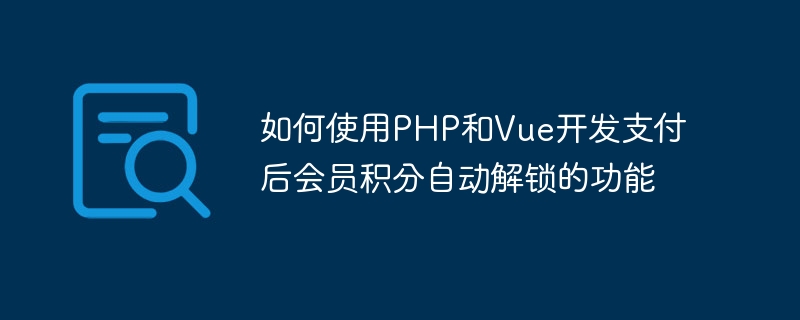Home >Backend Development >PHP Tutorial >How to use PHP and Vue to develop the function of automatically unlocking membership points after payment
How to use PHP and Vue to develop the function of automatically unlocking membership points after payment
- 王林Original
- 2023-09-24 09:03:11804browse

How to use PHP and Vue to develop the function of automatically unlocking membership points after payment
With the rapid development of e-commerce, more and more companies are beginning to pay attention to the membership system . In order to attract users, many companies provide membership points systems, and you can obtain some special rights or benefits by accumulating points through consumption. So, how to realize the function of automatically unlocking membership points after the user pays? This article will introduce how to develop this feature using PHP and Vue, and provide specific code examples.
First, we need a backend server to handle the logic of user payment and points unlocking. Here we use PHP as backend language. First, we need to create a database table to store the user's points information. You can create a table named "members" with the following fields:
- id: member ID, unique identifier
- name: member name
- points: Number of member points
- status: Member status, used to indicate whether it has been unlocked
Next, we can create a PHP file (such as unlock.php) to handle the unlocking of points after payment logic. First, we calculate the number of points that should be obtained based on the payment amount by receiving the parameters of the user's payment (such as member ID and payment amount).
<?php
// 获取用户支付的参数
$memberId = $_POST["memberId"];
$paymentAmount = $_POST["paymentAmount"];
// 计算积分数量
$points = $paymentAmount * 10; // 假设每10元获得1积分
// 更新会员积分信息
$conn = new mysqli("localhost", "username", "password", "database_name");
$sql = "UPDATE members SET points = points + $points WHERE id = $memberId";
$result = $conn->query($sql);
if ($result) {
echo "积分解锁成功";
} else {
echo "积分解锁失败";
}
?>In this way, when the user pays successfully, the number of points in the membership table will increase accordingly. Next, we need to use Vue to implement the points unlocking function on the front-end page.
First, we need to introduce Vue and axios libraries for data interaction with the backend. You can add the following code in the HTML file:
<!DOCTYPE html>
<html>
<head>
<meta charset="UTF-8">
<title>支付后会员积分自动解锁</title>
<script src="https://cdn.jsdelivr.net/npm/vue/dist/vue.js"></script>
<script src="https://unpkg.com/axios/dist/axios.min.js"></script>
</head>
<body>
<div id="app">
<h1>会员积分解锁</h1>
<input type="text" v-model="memberId" placeholder="请输入会员ID">
<input type="number" v-model="paymentAmount" placeholder="请输入支付金额">
<button v-on:click="unlockPoints">解锁积分</button>
<p>{{ unlockResult }}</p>
</div>
<script>
new Vue({
el: "#app",
data: {
memberId: "",
paymentAmount: "",
unlockResult: ""
},
methods: {
unlockPoints: function() {
axios.post("unlock.php", {
memberId: this.memberId,
paymentAmount: this.paymentAmount
})
.then(function(response) {
this.unlockResult = response.data;
})
.catch(function(error) {
console.log(error);
});
}
}
});
</script>
</body>
</html>In the data attribute of Vue, we define three variables: member ID, payment amount and unlocking result. In the methods attribute, we define an unlockPoints method to handle the logic of clicking the unlock points button. This method sends a POST request to the backend through the axios library, passing the member ID and payment amount as parameters to the unlock.php file of the backend.
After receiving the parameters, the unlock.php file on the backend calculates the number of points that should be obtained based on the payment amount, and updates the number of points for the corresponding member in the membership table. Finally, the corresponding unlocking result is returned to the front-end through the response, and the front-end page can display the unlocking result.
The above are the specific steps and sample code for using PHP and Vue to develop the function of automatically unlocking member points after payment. Through this function, users can automatically obtain corresponding membership points and enjoy membership privileges after payment is completed. This feature not only improves user experience, but also encourages users to make repeat purchases. Hope this article is helpful to you!
The above is the detailed content of How to use PHP and Vue to develop the function of automatically unlocking membership points after payment. For more information, please follow other related articles on the PHP Chinese website!

